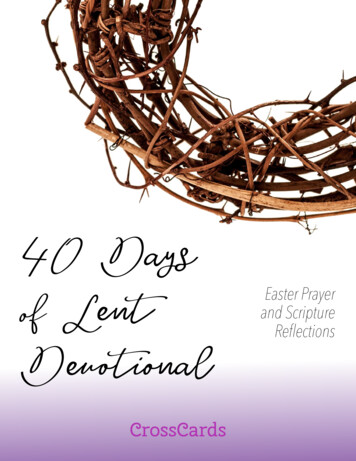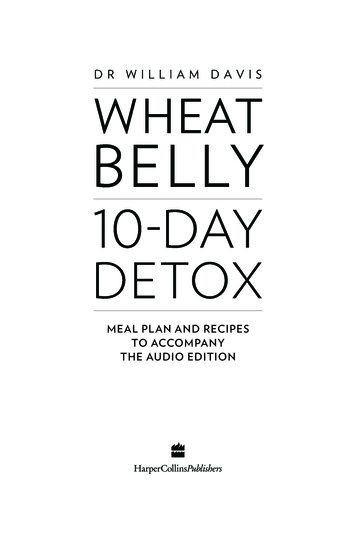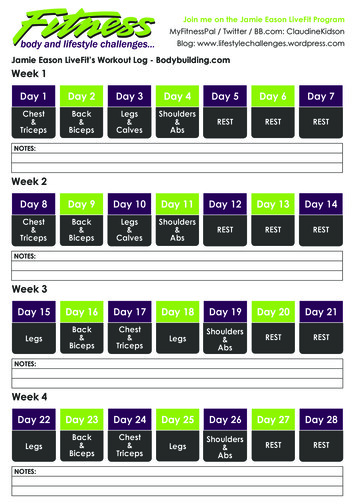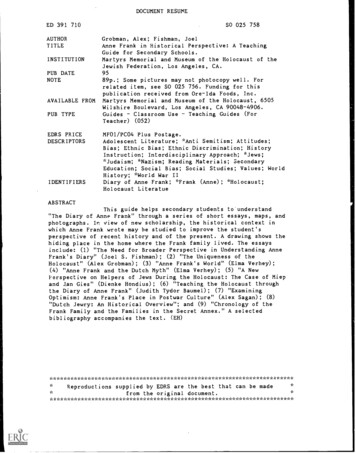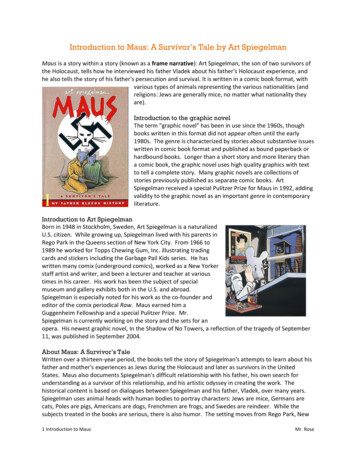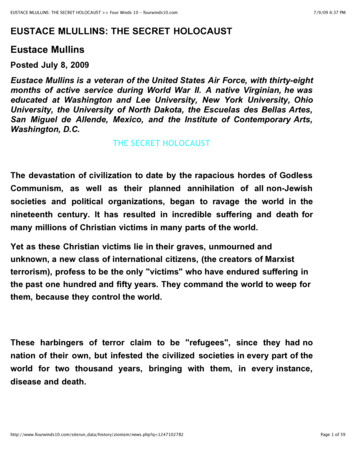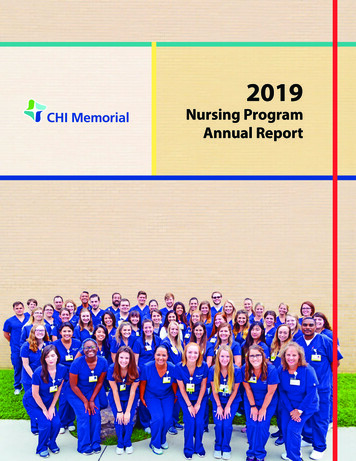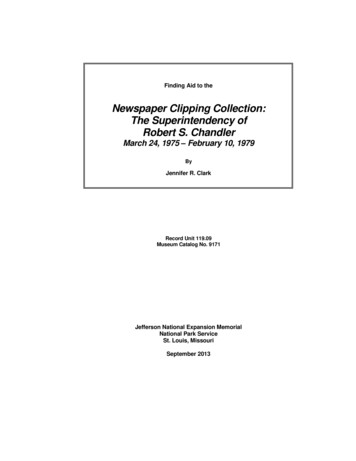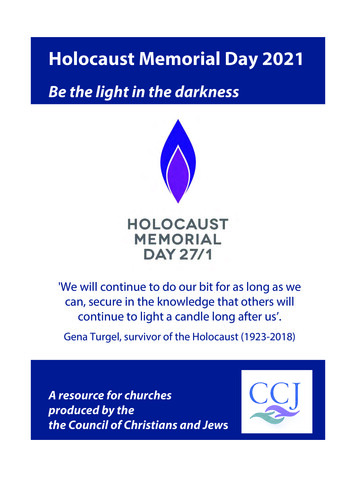
Transcription
Holocaust Memorial Day 2021Be the light in the darkness'We will continue to do our bit for as long as wecan, secure in the knowledge that others willcontinue to light a candle long after us’.Gena Turgel, survivor of the Holocaust (1923-2018)A resource for churchesproduced by thethe Council of Christians and JewsHMD Resource 2020.indd 112/09/2019 11:56:50
What is Holocaust Memorial Day?27 January is the day for everyone to remember the six million Jewsmurdered in the Holocaust, and the millions of people killed under NaziPersecution, and in the genocides which followed in Cambodia, Rwanda,Bosnia, and Darfur. 27 January marks the liberation of Auschwitz-Birkenau,the largest Nazi death camp.In the UK, thousands of local events and activities take place every year –each one an opportunity for people to reflect on those whose lives werechanged beyond recognition, and to challenge prejudice, discrimination,and hatred in our own society today. On HMD, we all have a role to play toensure that we learn the lessons of the past, to create a safer, better future.The theme for HMD 2021 is ‘Be the light in the darkness’. It encourages usto reflect on the depths humanity can sink to, but also the ways individualsand communities lit the darkness before, during, and after genocide.Outline of the resource What is Holocaust Memorial Day?Foreword and notes for using this resource in 2021Outline of an act of worship, including stone paintingA survivor's testimonyReflections on the readingsFurther resourcesThe Memorial to theDeportees, Yad VashemHMD Resource 2020.indd 312/09/2019 11:56:50
ForewordThe theme of this year’s Holocaust Memorial Day (HMD) is ‘Be the light inthe darkness’. This speaks to the heart of our faith as Christians. Jesus, thelight of the world, invites us to come to him and live in the light. Havingbeen brought into his light we are called to bring that light to others.Light reveals the truth and on HMD that light will reveal and remember theincomprehensible horror of the Holocaust; a darkness of what took place inthose years and a darkness when humans fail to live in the light of God’slove. The Holocaust was fuelled by an antisemitism which had been spreadby European churches. Indeed, for the last two thousand years EuropeanChristians have been a significant element in the development of antiJewish ideas and at times have participated in anti-Jewish violence. The lightreveals uncomfortable truths. How as Christians can we respond to thisfailure to live in the light of Christ? How is it possible for us to be the light inthe darkness?Since the Holocaust many Christians have rejected antisemitic teaching andsought new understanding of the relationship with Judaism. There is anacceptance of the need for repentance. For example, the Faith and OrderCommission of the Church of England in 2019 published God’s UnfailingWord: Theological and Practical Perspectives on Christian-Jewish Relationswhich states, ‘Repentance, in this as in any other context needs to identifyand name what is sinful, letting it be seen for what it is in the light of God’srighteousness’. The call to be the light in the darkness creates a genuineopportunity to reflect on and express our repentance for Christianinvolvement in spreading antisemitism. I hope for a multitude of lights inchurches across the country on 27 January shining God’s light into thisdarkness.Be the light in the darkness and take time to remember the millions ofpeople, of all faiths and none, murdered during the Holocaust, under Nazipersecution and in the genocides which followed in Cambodia, Rwanda,Bosnia and Darfur.During this Covid-19-shaped year the ease with which different faiths haveHMD Resource 2020.indd 512/09/2019 11:56:51
come together and responded to need has been uplifting. All over thecountry local initiatives have sprung up inspired by faith; churches workingalongside others, reflecting God’s love for each person. Building connectedcommunities is one way of resisting the darkness that can take hold whenwe fail to honour every individual as made in God’s image. Let’s be a light inthe darkness by continuing to build up connected communities as well as byusing this resource to mark HMD in churches across the country.Siriol DaviesNational Presence & Engagement Programme Coordinator, Mission & PublicAffairs, Church of EnglandMarking Holocaust Memorial Day 2021Every Holocaust Memorial Day is unique, but our commemoration in 2021 isespecially so.First, HMD 2021 is the first commemoration since the 75th anniversary of theliberation of Auschwitz-Birkenau in 2020. That anniversary was marked byinternational observances in Israel and Poland, and a CCJ event at the Houseof Lords in Westminster. It was the last major anniversary at which survivorsof the Holocaust will likely be present; we stand on the threshold of a newera of Holocaust education and commemoration in which we won’t have theliving witness of survivors. Second, the Covid-19 pandemic has magnifiedinequalities and social tensions, and enabled a worrying spike in racism andantisemitism in many countries.Partly in response to these two features of HMD 2021, this resourceencourages you to incorporate a creative activity into yourcommemorations: stone painting to remember individual victims of theHolocaust or other genocides. The Foundation Stones project is agovernment-backed initiative to gather painted stones from across thecountry to incorporate into the foundations of the future UK Holocaustmemorial and learning centre – literally forming the foundation for a new eraof Holocaust education. We encourage you to consider painting stones inyour local community group, church, interfaith gathering, or CCJ branch.HMD Resource 2020.indd 612/09/2019 11:56:51
This resource also assumes commemorations will take place on Zoom orother platforms. Please consider current government guidance whenplanning your HMD observance.The way we commemorate the Shoah in particular is changing, but oneaspect remains the same: the imperative to remember, to stand together,and to ‘be a light in the darkness’, wherever we live. Your role is crucial inthis, even if it is just placing a single lit candle in your window. Thank you fortaking part.Nathan EddyInterim Director, CCJFor more information on the Foundation Stones protect, undation-stonesThe Chief Rabbi speaks at Lambeth Palace in December 2018 to mark the80th anniversary of the start of the KindertransportHMD Resource 2020.indd 712/09/2019 11:56:51
Preparing a commemoration of HMD 2021The following prayers and readings reflect the theme ‘Be the light in thedarkness’ and are designed to work on Zoom platforms.If incorporating the Foundation Stones project into your commemorations,participants may wish to begin the event with the painting of stones, or todo this at some point in the order of service below, perhaps after thereadings.Before the event, participants should be invited to gather the followingitems: a flat stone or pottery or masonry shard for painting or colouring paint pens and markers or paints and brushes a candle for lightingAdditionally, participants may wish to reflect beforehand on the words orimage they will paint on their stones. There are many stories of survivors, forexample, which can be found at the HMDT web site by searching for ‘lifestories’ or visitinghttps://www.hmd.org.uk/resources/?genocide any&resource type 9&age anyFinally, consider in advance how you can collect the stones fromparticipants in a safe manner and send them to the Foundation Stonesproject. For example, participants could agree to individually place theirpainted stones in a public area for display – outside a church, for example –and the organiser could collect them at a later date. Post your stones to BigIdeas, Unit 1, 465C Hornsey Road, London, N19 4DR, or emailfoundationstones@bigideas.org for further details. Please also share picturesof your stones on social media using the hashtag #FoundationStones.HMD Resource 2020.indd 812/09/2019 11:56:51
Prayers for Holocaust Memorial Day 2021Participants are invited to light their candlesOpening wordsGod of light and life,we gatherto rememberWe gatherto stand against hateWe gatherto say, never againWe gatherto work for the flourishing of allGod of light and life,shine among usas we gather.A short time of silence is observedA prayer of confessionVoice 1: Friends, we are called to walk in the light. (John 8:12 and 12:35)Voice 2: Forgive the times we have followed ways of our own choosing.Voice 3: Set us in paths of righteousness, for your name’s sake. (Ps 23:3)SilenceHMD Resource 2020.indd 1012/09/2019 11:56:52
Voice 1: Friends, we are called to consider whether the light in us is notdarkness. (Luke 11:35)Voice 2: Forgive the times we have failed to share your light.Voice 3: Give us courage to share your light, together.SilenceVoice 1: Friends, the prophets denounced those who ‘who call evil good andgood evil; who put darkness for light, and light for darkness’. (Is 5:20)Voice 2: Forgive our cynicism that costs others so dearly.Voice 3: Sustain us as we seek the light of your life in the world.SilenceVoice 1: Friends, God brings even deep darkness to light. (Job 12:22)Voice 2: Let your light shine on us, O God, that we might live. (Is 9:2)Voice 3: Open our eyes and renew us, for in your light we see light (Ps 36:9)Amen.A prayer for use with young peopleGod of love, on this day we pray for the victims of the Holocaust and ofgenocides in other parts of the world. We pray that you send your light on allwho lost loved ones. We pray that you help us hear the words of survivors.We pray that the names of all victims will never be forgotten, but will beremembered by us and by those who come after us. We pray that our worldwill resist evil and intolerance, so that we can all live together in peace andprosperity. And we pray that you will help us be the light in the darkness.Amen.HMD Resource 2020.indd 1112/09/2019 11:56:52
Readings from scripturePs 431 Vindicateme, O God, and defend my causeagainst an ungodly people;from those who are deceitful and unjustdeliver me!2For you are the God in whom I take refuge;why have you cast me off?Why must I walk about mournfullybecause of the oppression of the enemy?3 O send out your light and your truth;let them lead me;let them bring me to your holy hilland to your dwelling.4 Then I will go to the altar of God,to God my exceeding joy;and I will praise you with the harp,O God, my God.5 Why are you cast down, O my soul,and why are you disquieted within me?Hope in God; for I shall again praise him,my help and my God.A short time of silence is observedJames 1:17 and 22-27Every generous act of giving, with every perfect gift, is from above,coming down from the Father of lights, with whom there is no variation orshadow due to change.1722 Butbe doers of the word, and not merely hearers who deceive themselves.if any are hearers of the word and not doers, they are like those wholook at themselves in a mirror; 24 for they look at themselves and, on going23 Foraway, immediately forget what they were like. 25 But those who look into theperfect law, the law of liberty, and persevere, being not hearers who forgetbut doers who act–they will be blessed in their doing.26 If any think they are religious, and do not bridle their tongues but deceivetheir hearts, their religion is worthless. 27 Religion that is pure and undefiledHMD Resource 2020.indd 1212/09/2019 11:56:52
before God, the Father, is this: to care for orphans and widows in theirdistress, and to keep oneself unstained by the world.A short time of silence is observedMatt 5:15-1615 No one after lighting a lamp puts it under the bushel basket, but on thelampstand, and it gives light to all in the house. 16 In the same way, letyour light shine before others, so that they may see your good works andgive glory to your Father in heaven.PoetryTestimony, by Dan Pagis (1930-1986)No, no: they definitely werehuman beings: uniforms, boots.How to explain? They were createdin the image.I was a shade.A different creator made me.And he in his mercy left nothing of me that would die.And I fled to him, rose weightless, blue,forgiving – I would even say: apologizing –smoke to omnipotent smokewithout image or ng of stonesIf incorporating foundation stone painting into your event, here is anopportunity for participants to paint their stones or to share their stones andthe stories behind them. Alternatively, a short reflection could be given on thereadings, or a time of silence observed.HMD Resource 2020.indd 1312/09/2019 11:56:52
Called to be a light: A litanyWhen faced with religious discrimination,Jesus calls us to be a light shining in the darkness.When faced with a global pandemic that threatens our wellbeing,Jesus calls us to be a light shining in the darkness.When faced with the darkness of shame and rejection,Jesus calls us to be a light shining in the darkness.When faced with human beings not being treated in a dignified manner,Jesus calls us to be a light shining in the darkness.When faced with discrimination for 'being different',Jesus calls us to be a light shining in the darkness.When faced with injustices caused in the name of religion,Jesus calls us to be a light shining in the darkness.When faced with people who are unable to live in their own countries andhomelands,Jesus calls us to be a light shining in the darkness.When faced with a lack of generosity towards refugees and migrants,Jesus calls us to be a light shining in the darkness.When faced with genocide,Jesus calls us to be a light shining in the darkness.When faced with denial of the Holocaust,Jesus calls us to be a light shining in the darkness.We look to the light of Jesus, so that as we reflect his light in theworld, it is filled with the harvest of his good works.Amen.HMD Resource 2020.indd 1312/09/2019 11:56:52
The Lord’s PrayerParticipants are invited to pray the Lord's Prayer together in whatever version ismost suitable.A short time of silence is observedClosing wordsAs we go from this place of prayer into a world of challenge and change,We remember the pain of the past.As we follow God’s command to let to our light shine,We recognise the opportunity of the here and now.As we seek the truth and glimpse God’s light in all people and places,We commit ourselves to sharing God’s light through hope and love.A shared benedictionMay the light of God shine on us,transform our lives,and brighten the world.Amen.Janusz Korczak Memorial, Yad VashemHMD Resource 2020.indd 1512/09/2019 11:56:52
A survivor's testimonyBlanche BenedickIn this educational resource for secondary agestudents, Blanche Benedick tells her story ofescape from the Nazis. Blanche's family wereJewish and lived in Nazi-occupied Denmark.They were helped to escape to Sweden byDanish and Swedish people who risked theirlives to help them make the crossing by boat.My name is Blanche Benedick and I was born in Copenhagen in Denmark,on 20 September 1933. My father had a small factory. He was a wonderfulman who could turn his hand to anything to look after the family. Mymother always seemed to be in the kitchen. I remember coming homefrom school and being greeted by delicious cooking smells. I had an olderbrother and sister from my father’s first marriage. My younger sister wasborn later, in Sweden.We lived in a second-floor flat in a mainly Jewish area in Copenhagen. Itwas a traditional Jewish home and we lit our candles every Friday night.We didn’t go to synagogue every Saturday, but we always went at festivaltimes. Before the war, we also kept the special dietary rules at home.I have very clear memories of the festival of Passover. Grandfather wouldgo through all the prayers and songs from beginning to end – which takeshours! I was only about 10 and we weren’t allowed to eat until he hadfinished – about 11pm! I used to sit and look at the painting on the wall –a table with a big bunch of grapes – and I used to count the grapes. I stillhave that painting at home today and I treasure it.As a child, I liked sports and singing, but I also loved playing outdoors. Ihad my dolls and pram and used to take them for walks on Sundays withMona, my friend from across the road.Mona was my best friend, but she wasn’t Jewish. We went to school onthe same tram, although to different schools. I started at a Jewish schoolHMD Resource 2020.indd 1612/09/2019 11:56:53
when I was about seven and can remember my first day. We had to wearlittle aprons and the first class was like nursery school; you learnt a fewthings and got used to playing with other children. I stayed at that schooluntil I was ten.When war broke out and the Germans invaded Denmark in 1940, wesuffered the same curfews and rationing as other countries, and there wasbombing. We had to run down to the cellar whenever there were air raids.There was a lot of talk about the Jewish people – that things were goingto get worse for them.One day at school, the headmaster called me into his office and said, ‘Youknow there’s a war on?’ And I replied, ‘Of course I do.’ By then I was tenand knew what was happening. He went on, ‘Well, Mona’s mother cameto see me today and said you have to go back to their house thisafternoon. Your mother and father are there as well.’ So I went back toMona’s after school.My mother was sitting crying and my father was pacing up and down,looking worried. Mona’s mother said, ‘Don’t worry, Blanche, you’re goingto stay here with us for a few days. We’re going to hide you becausewe’ve heard that all the Jews are going to be rounded up.’ That was inOctober 1943.Like many ordinary Danish people, Mona’s parents were wonderful anddid so much to help us – even though they were risking their own lives.There were about 8,000 Jewish people in Copenhagen at the time – andonly 450 were caught. Mona’s father was a keen photographer and had adark room to develop his pictures. He told me, ‘If you hear the Nazi policecoming up the stairs, run into that little room and keep very quiet.’ Thepolice actually came twice and it was very scary.We stayed there for about four days, but it wasn’t safe for Mona’s parentsto keep us very long. They arranged a taxi to take us to the coast –because our aim was to go by boat across to Sweden, which wasn’tinvolved in the war. I remember that in the taxi, my father gave me somemoney and said, ‘Keep that safe in your pocket. We’re going to hide youunder the rug, so if we get stopped, they might not see you. If we’reseparated, you’ve got your whole life ahead of you and might have achance of being saved.’ Fortunately, we were not stopped.HMD Resource 2020.indd 1312/09/2019 11:56:52
At the coast, we went to a big hut where the fishermen kept the catch ofthe day. There were some other Jewish people waiting there, but becausemy mother was pregnant, the fishermen took us in the first boat. Therewere about 20 of us, including some small children. The little ones weregiven a sleeping tablet so they wouldn’t cry or make a noise. We got intothe fishing boat at dawn the next day. The fisherman hid us under a bigtarpaulin and we set off.The journey across to Sweden usually took about two and a half hours,but that day it took ten because the fisherman had to keep stopping andthrowing his nets out, pretending to be fishing. It was very cramped anduncomfortable and we could see lights shining from German boats. It wasall very frightening. Fortunately, we arrived in Sweden safely.Once we arrived, we were taken to a church hall that had been turnedinto dormitories. In another room that was like a canteen, we were givena bread roll and some tomato soup. I remember we were only allowedone roll and one bowl of soup because more boatloads of people werearriving through the day and night.I didn’t go to school for that first year in Sweden, but I learnt Swedish veryquickly. After my baby sister was born in January 1944, I went to a niceSwedish school, where I was treated exceptionally well. We were the onlyrefugee family living in the little town and the local people did a lot tohelp us. I remember there was a school skiing trip, but we didn’t havemuch money at home so I didn’t say anything about it. One day when Igot to school, there was a weekend case on my desk. I put my hand upand said, ‘Excuse me, miss, there’s a case on my desk.’ And the teachersaid, ‘Yes, it’s for you.’ I opened it and inside there were sweaters, socksand mittens – everything you needed for a winter break. I burst into tearsand my teacher said, ‘Did you really think we’d go without you?’ Then shegave me a little brown envelope and said, ‘This is from the teachers. It’syour spending money – just the same as the other children.’We stayed in Sweden until 1945, the end of the war, then went back toCopenhagen. We were so happy to discover that all our family hadsurvived. We went to see if our flat was still there. Our lovely neighbour –again non-Jewish – had even rented it out while we were away and keptthe money for us.HMD Resource 2020.indd 1312/09/2019 11:56:52
Back in Copenhagen, I finished my schooling and met up with my oldfriends again. I desperately wanted to train to be a dress designer andwork for the biggest fashion house in Copenhagen. I got anapprenticeship there and qualified as a cutter and designer when I was18. Then I came to England in 1952, where I met and married my latehusband, but that’s another story.I like to tell my story to schoolchildren because I think they can learn frommy experiences. We live in a multi-racial society in England. We are luckyto live in a free country and should mix with everybody and try tounderstand other people’s culture. Think what the wonderful Danish andSwedish people did for me and my family.For discussion:Name the people in Blanche’s testimony who were ‘a light in thedarkness’ for her and her family.You can read more about Blanche ick/Thanks to the National Holocaust Centre for contributing Blanche’s storyto the resources collected by the Holocaust Memorial Day Trust.HMD Resource 2020.indd 1312/09/2019 11:56:52
Notes on the scripture readings and poemThe three readings from scripture touch on the theme of ‘Be the light in thedarkness’ in different ways and are taken from the New Revised StandardVersion. Although these are not lectionary readings for the Epiphany season,they do fit a general Epiphany theme of light.Ancient Israel associated God with light in its most ancient temple rituals andbeliefs (‘In your light we see light’, reads Ps 36:9). Sharing in this cultictradition, Ps 43 makes clear in its central petition that light is the creation andgift of God: ‘Send out your light and truth’ (v 3). A lament, Ps 43 is closelyrelated to Ps 42 but also stands on its own as an expression of suffering sideby-side with resolute hope. The desire for freedom of worship expressed invv 3-4 brings to mind the celebration of Chanukkah, the Jewish festival oflight, in camps across Europe during the Holocaust despite limited meansand appalling conditions. It also brings to mind other genocides in history.When the Khmer Rouge took power in Cambodia, for example, religion wasabolished and families were broken apart. The words of lament in Ps 43 arestill raw, yet from unknown depths it finds hope in its conclusion.The mention of the ‘Father of lights’ in the Epistle reading (James 2:17)seems to refer to God’s creating of the lights and bodies of heaven, as in Ps136:7-9 and Gen 1. James unequivocally connects this cosmic ‘Father oflights’ with the imperative that people of faith respond with righteous deedsand not just good intentions when confronted with suffering, especially thesuffering of vulnerable orphans and widows (compare with Exodus22:22-24). Children and unprotected women are often the first casualties ofconflict. During the war, 10,000 Jewish children were rescued and brought toBritain in the Kindertransport; but hundreds of thousands more childrenperished (one estimate puts the figure at 1.5 million). Reading James in thiscontext reminds us of the importance of our collective and individualactions, and of the cost of failing to act.Jesus’ words in Matthew 5, from the Sermon on the Mount, are of a piecewith Matthew’s stress on the importance of action (not just faith) elsewherein his gospel, as in Matt 25:32-46, for example. Jesus’ words also stand in along line of similar instructions in the Bible; Ps 112:4, for example, praisesHMD Resource 2020.indd 1712/09/2019 11:56:53
those who fear the Lord because ‘They rise in the darkness as a light forthe upright’. These words challenge us to act, and the divine associationswith light in the ancient world challenge us to see God’s actions in thesehuman actions of sharing light.The Israeli poet Dan Pagis was born in a German-speaking Jewish familyin Bukovina, Romania (present-day Ukraine), and was interned in aconcentration camp as teenager before escaping in 1944 and emigratingto Israel. He wrote in Hebrew, a language he learned only as a teenager,and his first poems about the Holocaust appeared 25 years after theevents. He also taught medieval Jewish literature at the HebrewUniversity.The poem ‘Testimony’ draws attention to the experience of the victims ofthe Shoah, not the perpetrators. The perpetrators are just ‘uniforms andboots’; instead we are drawn the survivor’s voice. Like so many survivorsof the Holocaust and other traumas, the poet’s life is changed. He is morelike smoke than a human being – a shade or shadow, in the centralstanza, rather than an ‘image’; in the Hebrew original, there’s wordplaybetween these two words, as they differ only by one crucial letter(‘tzelem’ and ‘tzel’ are the words for ‘image’, and ‘shade’, respectively).Being a ‘shade’ or a shadow is a poignant and troubling description of lifeafter trauma, and fits with our 2021 theme. Life does not simply return to‘normal’ after events like those Pagis experienced. Moreover, the poet,who did nothing wrong, even feels the need to apologise to God in thelast stanza – an example of the survivor’s guilt that has been welldocumented amongst survivors of the Shoah and trauma in general. Thepoet’s shadow-like existence is a challenge to the closure we seek in artand literature, and even in a HMD service; although the poet has lived totell the tale, there is no happy ending here, no easy comfort. A simplecontrast between light and dark is not appropriate here; the shadowspersist even in the light of liberation.The poem also voices anger at humanity: ‘No, no, they were definitelyhuman beings’, reads the first line. The perpetrators were not monsters oranimals. They were created in the image, they were humans like us. Thehumanity of the perpetrators is a reminder of genocides in Cambodia,Bosnia, Rwanda, and Darfur. The only hope is that human beings ‘be thelight in the darkness’, not the perpetrators of violence.HMD Resource 2020.indd 1312/09/2019 11:56:52
This poem directs our attention to the victims, in empathy, and to ourshared human nature, in resolve. It’s perhaps this journey as readers fromsmoky formlessness to anger and resolve that is this poem’s hope. Even so,the shadow-like existence of the survivor is a haunting and significantimage for our 2021 theme.Further /Whatever you are planning, please let us know at cjrelations@ccj.org.ukand/or share your event with HMDT directly on their interactive memorial-day/activitiesform/Acknowledgements:Thank you to Siriol Davies, for contributing the Foreword and to Fr JanNowotnik, National Ecumenical Officer for the Catholic Bishops Conferenceof England and Wales, for the contributing the litany. The prayer ofconfession follows the pattern of the confession in CCJ’s 2019 resource,written by Revd Bruce Thompson, Chair of the Lincolnshire MethodistDistrict. The closing prayer is adapted from CCJ’s 2020 resource.CCJ is grateful to recent funders of the Yad Vashem Alumni Programme:The DavisFoundationHMD Resource 2020.indd 42The Archbishop ofCanterbury’sDiscretionary Fund12/09/2019 11:57:01
CCJThe Council of Christians and JewsMary Sumner House24 Tufton StreetLondon, SW1P 3RBwww.ccj.org.uk020 3515 3003 cjrelations@ccj.org.ukfacebook.com/TheCCJUK @CCJUKIn association withThe International School of Holocaust Studies, Yad VashemHMD Resource 2020.indd 4412/09/2019 11:57:02
Be the light in the darkness 'We will continue to do our bit for as long as we can, secure in the knowledge that others will continue to light a candle long after us’. Gena Turgel, survivor of the Holocaust (1923-2018) . even if it is just placing a single lit candle

![Welcome [dashdiet.me]](/img/17/30-day-weight-loss-journal.jpg)
